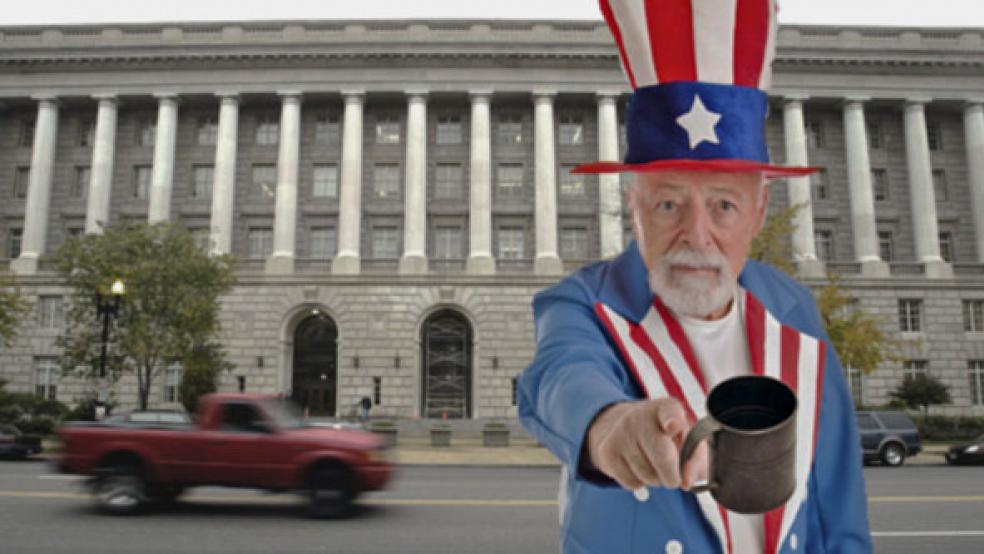Pop quiz: what is the biggest and most out-of-control part of the federal budget, costing $1 trillion per year and growing several times the rate of inflation?
Social Security or Medicare? Not quite. Big as they are, neither of the two giant entitlement programs will hit the $1 trillion mark for at least another seven years.
The correct answer is “tax expenditures,” budget jargon for the vast web of tax breaks that permeates and subsidizes almost every corner of American life: home mortgages, health insurance, retirement savings, domestic manufacturing, oil drilling and green energy.
Though lawmakers and policymakers battle loudly and constantly over spending on entitlement programs, the automatic growth of existing tax loopholes and incentives attracts almost no public attention at all.“I had to learn the hard way as chairman of the Ways and Means Committee that what defines and drives tax policy is not what’s good policy,” said Bill Archer, the Texas Republican who chaired the tax-writing committee from 1995 until 2001. “It was primarily driven by politics, with the second biggest driver being the budget.”
The federal tax break for employer-provided health care programs — the most popular of tax expenditures — will result in the government forgoing a total of nearly $160 billion in revenue this year. The tax breaks that homeowners receive on the interest they pay on their mortgages will cost the federal government $92 billion, while the federal income tax credits for children will total $23.5 billion this year.
The aggregate cost of these tax breaks hit a new milestone in 2009, according to estimates by the Treasury. In what appears to be a first, the revenue losses from tax expenditures last year — $1.08 trillion — slightly exceeded total collections of personal and corporate income taxes.
But analysts say that automatic cost escalation, which is similar to the formula-driven growth of Medicare and Social Security, could add almost $3 trillion to the public debt over the next ten years.
“Budget wonks rail about limiting entitlement programs like Medicare and Social Security,” said Leonard Burman, a longtime tax policy analyst at Syracuse University . “But a large and growing share of federal spending is off the radar screen. Tax expenditures are on autopilot. They’re big, at more than $1 trillion per year, and growing faster than the economy.”
Last week, the Senate voted 70 to 28 for a $15 billion jobs bill that offers tax credits and other temporary tax relief to companies that hire unemployed workers in 2010. It was the only version of a jobs bill that could muster sufficient support from both Democrats and Republicans.
In his budget proposal for next year, President Obama proposed narrowing a number of breaks to save a total of $750 billion over 10 years. But he would also create or permanently expand other tax breaks at an estimated ten-year cost of $284 billion.Obama has also proposed saving $250 billion over 10 years by imposing a three-year freeze on a big part of nondefense domestic “discretionary’’ spending — programs and services that Congress must vote to fund each year.
But Mr. Burman estimated that a similar freeze on tax expenditures would save 14 times as much – a whopping $3.5 trillion over ten years.
Even if the government could just cap growth at the rate of inflation, Mr. Burman estimated, it would save $2.85 trillion by 2020.
As a practical and political matter, policy analysts say it would be virtually impossible to impose simple across-the-board limits. Even the most obscure incentives have powerful political defenders, and many of the biggest affect millions of individual taxpayers.
Archer, the former Ways and Means chairman, noted that the sweeping tax overhaul of 1986 nearly foundered in his committee because lawmakers from New York and other high-tax states adamantly opposed a provision that would have eliminated the deduction for state and local income taxes. That deduction — worth a total of $52.7 billion this year — was reinstated.
Archer said he philosophically disagrees with the idea of equating tax breaks with spending. He said the idea of “tax expenditures” implies that the government has a full claim of ownership on people’s incomes, which he said is wrong.
But critics of the system say the hidden costs point to the need for a broader overhaul, like the 1986 legislation that eliminated scores of big breaks while lowering overall tax rates.
The automatic escalation is hard-wired into many tax breaks. As real, inflation-adjusted incomes go up, for example, the value of tax deductions goes up because more people are nudged into higher tax brackets. Likewise, rising medical costs drive up the cost of tax-free company-paid health insurance.A growing number of “refundable” tax breaks are almost indistinguishable from traditional spending. The child tax credit, for example, is available to many families that didn’t owe any income in the first place. The Internal Revenue Service simply sends them a check.
Somewhat similarly, last year’s economic stimulus bill expanded the use of tax-loss “carrybacks” to stimulate business activity. Companies that book losses this year can get cash refunds for taxes they paid on profits during the previous five years.
Many of the biggest tax breaks — for mortgage interest, company-paid health insurance and retirement savings accounts — often seem politically untouchable.
The cost of tax-free employer-paid health insurance, which the Treasury estimates will hit $160 billion this year and soar to $248 billion in 2015, is already at the center of the brawl over health care reform.
But when the Obama administration proposed to finance part of his health care plan by reducing the tax break for expensive “Cadillac’’ insurance plans, labor unions and other groups vigorously protested.
Mr. Obama’s initial proposal would have affected only plans costing more than $23,000 a year and would have saved $100 billion over ten years . His newest proposal would affect even fewer plans, and would not take effect until 2018.
Beyond the political problems, experts say, an across-the-board limit on tax expenditures would pose the huge practical problem of redesigning the terms of almost every provision.The mortgage interest deduction is open to anyone who qualifies for it. Its $92 billion total annual cost is derived from housing prices, interest rates, the number of homeowners and their average tax bracket.
Kenneth J. Kies, a tax lobbyist in Washington and founder of the Federal Policy Group, said it’s difficult to put a cap on the total cost of a tax break such as the mortgage interest deduction because the cost depends on a variety of factors, including the number of people who have mortgages. “The practicalities are real obvious,’’ Kies said. “Would you say if more people have mortgages, the deduction should be lower?”Many analysts say a more plausible approach is to pursue a top-to-bottom overhaul that both wipes out many tax breaks and lowers overall tax rates.
The 1986 overhaul did just this, with President Ronald Reagan working closely with Democrats in Congress. But although the number of tax expenditures plunged for several years, their volume and cost more than rebounded in the decades that followed.
A similar tax overhaul has now been proposed by Sens. Ron Wyden, D-Ore., and Judd Gregg, R-N.H.
Their proposal, unveiled in late February, would reduce the number of tax brackets to three — 15 percent, 25 percent and 35 percent — and reduce the corporate tax to 24 percent from 35 percent. Though the plan would keep some of the big breaks, such as for mortgage interest, it would eliminate scores of others for both individuals and businesses.
“By simplifying the tax code and scaling back tax breaks for special interests, we can give everyone an opportunity to get ahead,” Wyden declared last month . “Businesses of all sizes will be in a better position to compete and grow jobs. Working families will keep more of their hard earned dollars.”
Obama’s biggest proposed whack on tax breaks, estimated to save $291 billion, would limit the value of tax deductions for people in the top tax bracket.
He has also proposed new restrictions on the ability of multinational companies to defer taxes on overseas profits, which would save an estimated $122 billion over 10 years.
But he would also permanently extend other tax breaks for middle- and lower-income people. The additional breaks include an expanded child tax credit, an expansion of the Earned Income Tax Credit for low-income parents, and the Making Work Pay credit, which offers workers a break of $400 against Social Security taxes.“It’s become the preferred way of funding special programs or expanding existing ones,’’ said Eric J. Toder , a tax policy analyst at the Urban Institute in Washington. “It’s problematic because it creates a false public perception that if you run a program through the tax code then it’s somehow a tax cut rather than government spending.’’





